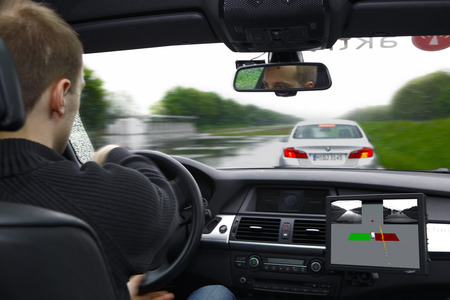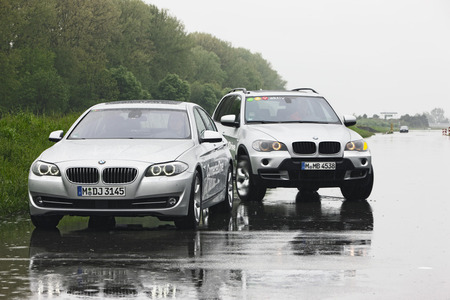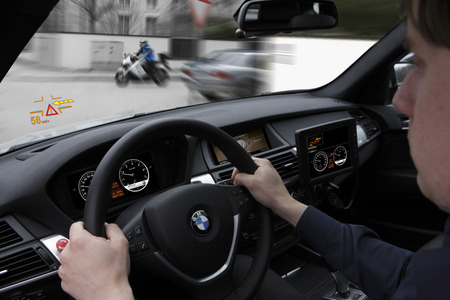BMW showcases traffic flow and safety innovations
Last updated Jun 28, 2010 — 111 views BMW and several other members of Germany’s AKTIV initiative on June 23 presented results from various intelligent transport systems (ITS) R&D projects. BMW says its AKTIV contributions have included innovations to vehicle safety, smooth traffic flow, and “vehicle-2-x” communications, including support for motorcycles.
BMW and several other members of Germany’s AKTIV initiative on June 23 presented results from various intelligent transport systems (ITS) R&D projects. BMW says its AKTIV contributions have included innovations to vehicle safety, smooth traffic flow, and “vehicle-2-x” communications, including support for motorcycles.
BMW describes its key contributions to AKTIV’s projects and sub-projects as follows:
- “Active safety” driver assistance — The best protection against accidents a car designer can drivers is the vehicle’s “active safety” capabilities, notes BMW. “From official statistics and from our own analyses of accident databases in the project, we know that many accidents are attributable to a driver reacting inadequately, too late, or not at all,” explains Dr. Peter Zahn, a project manager at BMW’s R&D facility.
“Every tenth of a second’s reaction time gained makes a crucial contribution to accident avoidance if a vehicle thinks for itself with lightning speed in critical situations and can itself react during a momentary lapse of attention on the part of the driver.”

Active Safety systems warn drivers of imminent nose-to-tail collisions
(click image to enlarge)
A fundamental challenge in attempting to enhance driver responsiveness to critical situations, according to BMW, is to immediately intervene when an unexpected accident threatens, in order to safeguard the driver, but without “overly nannying” drivers in their attentive, independent conduct at the wheel.As part of AKTIV’s “Active Safety” project, BMW has contributed to developing the Active Hazard Braking assistance system. This function goes beyond limiting the consequences of a collision, which existing emergency braking systems are chiefly designed to do; its aim is to completely eliminate, as far as possible, nose-to-tail impacts. To achieve this, laser scanners on the vehicle monitor the road situation ahead and to the side, while radar sensors provide surveillance of the area to the rear. In addition, the driver’s behavior in a particular situation is evaluated.

Active Safety systems can help drivers avoid nose-to-tail collisions
(click image to enlarge)
“If the sensors recognize the threat of a collision, the driver is appropriately alerted to the situation and, if necessary, the brakes are applied fully to avoid an accident,” explains Philipp Reinisch, an Active Hazard Braking specialist at BMW’s R&D facility.
- Car2x communications — Another key area of ITS research at BMW’s R&D facility is “Car2x communications,” which refers to vehicle-to-vehicle (V2V) and vehicle-to-infrastructure (V2I) data communications. Data from other road users, captured via Car2x communications, provides a basis for a driver assistance system developed in the Intersection Assistance subproject, the company reports. As implied by the photo below, BMW’s “Motorrad ConnectedRide” technology also integrates motorcycles into the Car2x communication network.

A heads-up display warns of a potential collision with a motorcycle
(click image to enlarge)
“If this assistance system discovers that the motorist giving way is probably misjudging his approach, the system warns him of a potential collision through a visual and audible signal,” explains Dr Felix Klanner, who developed the Intersection Assistance system at BMW’s R&D facility. “During the response time, the system also activates approximately 30 percent of the maximum braking force for one second — a palpable indication to the driver to apply the brakes himself.”“In parallel with this, a motorcycle with right of way deliberately attracts attention to itself: full beam headlights, additional LED side warning lights and the hazard lights are activated to broaden its silhouette. In the case of acute danger of collision the motorcycle’s horn also sounds. Its handling is not affected by this,” Klanner adds.
Other sub-projects within the Active Safety project were the development of Integrated Lateral Assistance, Pedestrian and Cyclist Safety, and the crossover project Driver Awareness and Safety.
- Intelligent traffic management for free-flowing traffic — BMW also demonstrated “Adaptive Navigation,” which makes use of data collected from multiple existing sources of navigation information, such as loop data, Floating Car Data, Extended Floating Car Data, mobile phone data, and historic traffic load curves.
“However, we are only at the start of this journey and the future will bring us a wealth of new information sources,” explains BMW’s Dr. Irina Matschke. “In particular, aggregators like Google and the virtual communities of Facebook, Twitter, or MySpace will exploit their strengths to flood the market with information offers, some of them free of charge. But in all of this, one thing will tend to be generally overlooked: the customer’s desire for reliable, high-grade information.
“The challenge lies in creating a unique body of high-grade information from diverse data sources, each with a small but known value,” Matschke continues. In order to integrate these data sources, BMW’s “fusion logic” combines the various information sources and allows them to be used by the customer through routing, according to the company. “In this way, as soon as the customers start their journeys, they are presented with a precise picture of what they can expect while driving and when they will reach their destinations under typical conditions, but also in the best or least favorable circumstances,” the company states.
- Mobile phone-based traffic data exchange — AKTIV’s Cooperative Cars project has been investigating the extent to which mobile phone technologies, such as UMTS, are suitable for the real-time exchange of data between traffic management and driver assistance systems. As part of this activity, BMW’s R&D facility has been investigating the performance of these mobile phone technologies in a test vehicle, as well as in simulations, and is assessing to what degree they can be utilized in cooperative assistance functions such as Intersection Assistance, according to the company.
AKTIV, which stands for “Adaptive und Kooperative Technologien für den Intelligenten Verkehr” (translation: “adaptive and cooperative technologies for intelligent transport”) is a collaborative research project chartered to develop innovative ways to enhance road safety, relieve drivers, and harmonize traffic flow. Members of the AKTIV initiative participated in 15 sub-projects, focused on developing next-generation driver assistance systems, solutions for efficient traffic management, and suitable vehicle-2-x communications technologies. The initiative’s 28 members include automobile manufacturers and suppliers, electronics, telecommunications and software companies, research institutes, and highway and traffic administrations.
Further information regarding the AKTIV initiative on the group’s website.